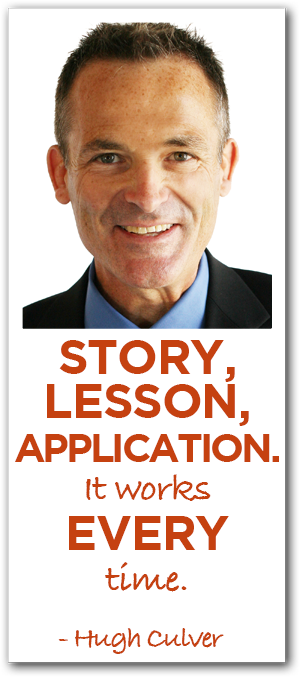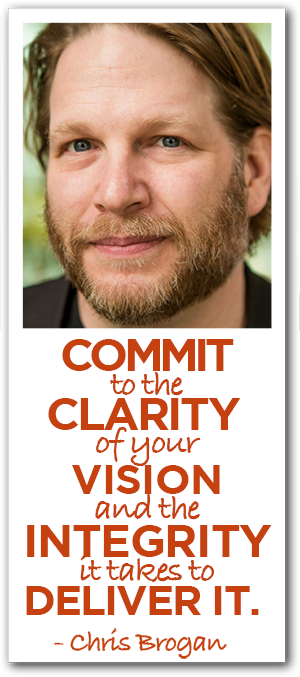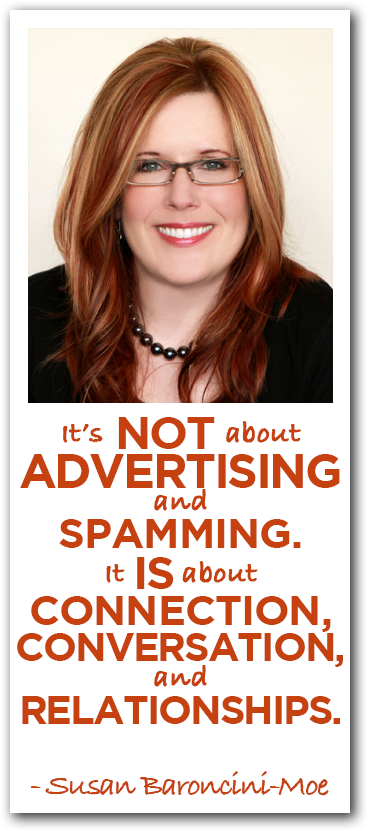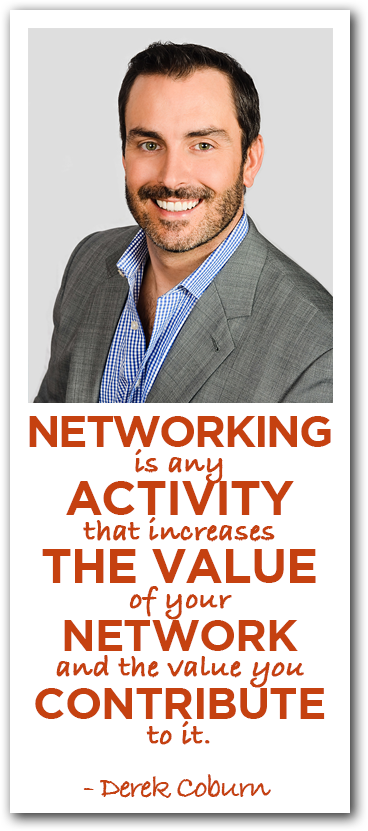 Are you attending networking events and not generating any business leads? Do you know how to utilize social networks to extend your networking to relevant clients? Do you know how much time to dedicate to your networking efforts?
Are you attending networking events and not generating any business leads? Do you know how to utilize social networks to extend your networking to relevant clients? Do you know how much time to dedicate to your networking efforts?
If not, then you’re not alone. A lot of small businesses don’t know how to approach networking in an effective way. By using certain tools and techniques, you can get the most out of your time and effort and quit wasting time at the same old events.
This week, we bring in Derek Coburn, author, financial advisor, and networking expert, to talk about how we can get the most out of all networking opportunities and give us relevant leads and connections.
Podcast: Play in new window | Download
Subscribe:
Big Ideas:
How did you get to be known for networking and how did you end up writing this new book?
- Wow, so we’ll be skipping over a lot to get there! Ha ha…
- I am still relatively unknown, and that’s fine, but I had a wealth management business that I had built up and primarily was successful in terms of qualifying for certain events and hitting certain thresholds in that business.
- People in that industry would say, “okay this kid is doing really well.”
- I mainly got to that point by being great at cold calling. I sort of joked to say that the reason that my business took off was that I was better at dealing with rejection than anyone I knew.
- I got to a point that I was working 80 hours a week for eight or nine years and had a lot of clients that I don’t like working for and I don’t like the arrangement we have. I wanted to put myself in a position were I could find people I had more in common with and people that I could better serve.
- Networking and going to these events was sort of the natural next steps and backing off of cold calling.
You seem to not like these giant networking events. What is not working when going to a network event for you?
- I think that the biggest problem with networking events is that the larger ones is that most people show up for completely different reasons. Whether you’re there to look for a new job, to land a new client, to meet a couple of great professionals to collaborate with – none of those answers or reasons are wrong per se, but when you have a lot of people converging on one location for different reasons it’s gonna be hard for anyone to consistently get value and feel like they’re using their time wisely.
- So, for that reason most people network, and unlike cold calling when they go to these networking events, you don’t feel that rejection.
- I know so many smart people that in my industry or another industry had to go find something else to do for a living because they couldn’t handle slamming the phone down and getting stood up for meetings multiple times a week.
- With networking events you can go to them three or four times a week and have relatively nice conversations with nice people and because you’re not feeling that ouch factor, just continue to do it and waste so much time.
- In some cases people never realize how much time they’re wasting because they never really get that negative reinforcement to remind them that it’s not the best use of their time.
Let’s say we’ve come to the conclusion we’re just not generating enough business from these networking events. What do we do? How do we fix this?
- So, I make an attempt to redefine networking at least for the purposes of my book and what I do with Cadre in Washington, DC with my wife.
- I define networking as any activity that increases the value of your network and the value you contribute to it.
- I think that’s a pretty good definitely of networking for professionals who aren’t looking for jobs who recognize that it’s not a place to go to pitch your goods and services. It’s a place you go to connect with other professionals that are at a level that you’re at or maybe interested in the same things you’re interested in.
- The problem is that most books and advice around networking centers around this sacred cow of a large networking event. The advice is sometimes good, but it’s normally “get a higher quality grade paper for your business card,” and “only drink for the first half hour,” and “when you follow up, use this word and not that word.”
- I think that because networking events are sort of already past the point where we’re going to fix them or change them. What I have found to better a better solution is to not go to them all together.
If the networking events aren’t working for us then what should we do? What did you do when you decided to create a new type of networking?
- Well, my reasons for networking were to develop these relationships with other professionals and get together to find ways we could potentially help each other out.
- I compare networking to dating. If you’re approaching networking from a long term perspective and looking to develop relationships the right way with other professionals, the dating equivalent of that is looking for the love of your life.
- If you were to buy the best dating books on how to find my soul mate, how to find the person I’m meant to be with, none of those books start off with “continue going to bars and night clubs every night.” It’s more about leveraging your friendships, hosting dinner parties, doing things that were the complete opposite of what you were doing.
- I started figuring out ways I could borrow form the dating world and apply some of these strategies to what I was doing with my clients and as an extension, some of the people they knew and the relationships with related people.
In your book, you mention a “connector.” Tell us a little about the connector model.
- The connector model is a series of strategies, a lot can be applied individually and I’ll share a few of them with you, and I think they could work really well on a one off basis for just about anyone, but when you put them all together it takes you through the strategy I use.
- What I ended up doing was putting together my own networking group that consisted of about twenty five professionals. They were some of my clients that were great clients but also business owners that would perceive this as a value extension in terms of what I was bringing to the table by facilitating introductions and making connections between them and other clients and professionals that I knew.
- Then I would go out and find others that I would hand pick and find ways to bring them into the fold.
- I would host a variety of events and would focus on ways that I could add more value for them and to a large extent my networking events are always successful because they start and end with, “what can I do to make this really great for a current client of mine.”
- I find ways to incorporate networking and events and interacting in different types of settings where, worst case scenario, my client enjoyed themselves, but best case scenario, I’m going to be in the same room with other people that could end up becoming clients of mine.
So, rather than go the traditional networking route, you brought your own core group of people you knew and trusted and you brought them together to try to get as many valuable connections as possible.
- Absolutely. “Clients” is the first part of the “connector” acronym. “C” for “clients.” It’s really about, “what can I do for my existing clients,” which is a way to go above and beyond the core deliverable that I’m providing them.
- I had an experience, a story that I share in the book, with a client of mine (names are changed of course), I refer to him as David the landscaper in the book.
- David called me up back in 2009 and said, “hey man, I received a call from one of my best clients and they have a family member who’s getting into the wealth management business” and they want me to take meeting with them.
- I let them know how great our relationship is and I wasn’t looking to make any changes, but they said, “just take a meeting with this person” and I’d be doing them a big favor. I said, “no problem, thanks for letting me know.” I gave him a summary of what he had with me and he called me up a few days later after the meeting and said, “Derek, so I met with this advisor and I got a bit of a pitch that took about forty five minutes and at the end he revealed a portfolio that had I been investing my money with his firm for the last couple years I would’ve averaged two or three percent more per year than what I had by investing with your firm.”
- His reponse was, “Derek’s referred me to really great clients over the past two years that have generated me over two million dollars of revenue for my business. So, in theory, Derek and his firm could’ve lost half the money in my portfolio (which we didn’t do), and from a net perspective I would’ve been better off working with him.”
- What I realized was that I was doing this sort of thing for my clients on a regular basis but what if I could, as an extension of what I was doing as a financial advisor, almost become an extension of my clients’ business development and marketing departments? Because hey, who doesn’t love to receive a great referral?
- If I was able to focus my networking efforts and outreach to other professionals when identifying the opportunities for my best clients, then they would love me even more and would be more receptive to introducing me to more people that they knew.
- So that was at the core of a lot of what I do.
Do any social networks fit into your networking plan, or is that something completely separate?
- I love Twitter. The reason I love it is that I use it and approach it as if it is the world’s best networking event in terms of its size. It’s always open. You get to see who’s there and who you want to connect with.
- I just shared a story with you that highlighted how my focus and networking efforts would be focused on my best clients. What I talk about in the book and what I’ve mentioned before, is let’s say networking 1.0 is all of us showing up at networking events and we thought we were going to meet clients when we went to an event.
- For most of us, that wasn’t going to happen and we changed gears and unfortunately there are still a few people out there practicing networking 1.0.
- So then, networking 2.0 is this idea of, “hey, we just met for the first time and I’m really interested in you and how I can help you,” which I think is kind of weird. I think that people that use this approach, and I’m all for paying it forward, but if you’re at an event and someone comes up to you that you barely know and they say, “hey, what can I do for you, how can I help you?”
- I always say, “what’s going on with this person and their business that they’d be so willing to go out of their way to help somebody that they just met?”
I get squeamish when somebody comes up and says, “how can I help you?” at a networking event. It comes off as disingenuous.
- Yeah, there can also be problems with these people when they approach networking they approach it from a quid pro quo perspective. If I give this person a referral I’ll get one, but you really have to be careful about who you introduce, especially if it’s a good client.
- If you’re putting a good client of yours in the hands of someone you don’t know that well in the hopes that they will do a great job for your client and then pay you back by giving you a referral, the risks far outweigh any potential rewards.
- What I call networking 3.0 is when you’re meeting people (and this is what I do on Twitter a lot) it’s me showing up at these places thinking about my best clients and what they currently need and are interested in.
- So, if I were to go to a physical networking event and I meet someone and as soon as the person says, “what do you do?” I say, “I’m a financial advisor,” there’s always this really quick excuse, “I don’t have any business cards and I never want you to call me.”
- Somebody may say to me, “I’m currently saving up all my money to buy a new house and I’m not really in the market for a financial advisor,” and I’ll say, “that’s great,” and what I immediately think about are real estate agents in my network that I can connect them with.
- I’ve found this to be one of the more effective and productive ways that you can connect and develop relationships with people because in this scenario, if I introduce the person that I just met to the person I have more of a relationship with, like my real estate agent, I’m potentially setting something up really valuable for my real estate agent.
- I’m not really putting myself in any sort of scenario where there going to be mad at me. I say, “hey look, I just met this person and they say they’re in the house for marketing.” Now, they could’ve been lying and potentially wanted to blow me off, but if they were being sincere then I’m doing them a favor by connecting them with a great real estate agent and if they end up working together (and that sometimes ends up happening), they remember you as the glue that kept it together.
- Obviously, I’m going to be the person they reach out to once they buy their house, they’re in their house, and now they have some money to potentially invest.
- This is really easy to do on Twitter. So, the next time you’re on Twitter, a lot of people show up and say, “what do I want to push out there about myself or how can I do this for this person.”
- If you think about some of the best clients have, or prospective clients you’re trying to work with and just listen to what other people are saying, you can really do some effective networking and meet prospective clients by just listening and making those connections.
In the book you mention using LinkedIn to find some people. Walk us through that process.
- Alright, for LinkedIn, if you are sort of buying in to what I’m talking about and being this connector and being somebody people are turning to in your network as a resource, you want to make sure you can deliver as much as possible.
- What I mean by that is if someone came to me to say, “hey, I’ve been to you for two other things and you’ve been really helpful, do you know a really great chiropractor or a really great interior designer?” If I say, “no,” then I’m really lowering the potential they’ll come back to me again the next time they need something.
- One of the strategies that I use that has really worked well for me on LinkedIn is I would send InMails to professionals who were in industries where I didn’t really know anyone.
- A good starting point for me was if I had clients or individuals that were part of my networking group say, “hey, do you have a recommendation for ‘x’?” and I didn’t know anyone I would reach out to them and I would say, “I’m looking potentially for a great ‘fill in the blank’ to refer my clients to.” This is all coming from a point of complete authenticity.
- There are ways that people can manipulate this, but I would simply say, “hey, I’ve been asked recently by clients or otherwise for an introduction to someone who does what you do. I currently don’t know anyone, but based on our mutual connections and what you’re doing on paper it sounds like you’re doing a great job and I would love to schedule a ten minute phone call to learn more about you. If I get asked this question again going forward I’ll know if you’re someone I feel comfortable recommending that I could help.”
How much time should we be dedicating to networking?
- The first thing that I’ll share is regarding time. I hosted six wine tasting events – one per quarter, spanning a year and a half, and I ended up generating about $150,000 of revenue from new clients that I previously wasn’t working with, that attended these events.
- I know that your show is all about helping your listeners find their ideal clients and to leverage different types of marketing, so I’ll walk you through the process for how to do this.
- I would reach out to my best clients and tell them we’re setting up a networking event and let them pick the best dates for all of them. I would say, “we’re putting this thing together. We’re going to serve some good wine, we’re gonna have good food. It’s gonna mostly be about connecting and catching up and having a good time, but there’s also going to be 10-15 minutes of some sort of information, something that’s relevant to our industry that we think will be good for you to hear.
- Every invitation to my clients was for them to come, and in some cases their spouse, but also they were able to invite up to two more people to join them. While they could invite anyone they wanted, I really tried to encourage them to bring their partners, fellow board members, or best clients. We’re not going to do any pitching, but if you feel like they may be an ideal client for us that would be great if you could bring them.
- What would happen is that people would show up. There wasn’t a pitch. There wasn’t any expectation. I would spend about 10 minutes giving an overview of a topic that in all likelihood would be new or interesting, or something they probably haven’t heard from their existing financial advisor. It wasn’t like a get rich quick thing. It was more of something to make them think like, “I wonder why my financial advisor hasn’t brought this up to me before?”
- So, what would happen at the end was I don’t have to sell in that environment because I have 15 clients and 15 guests, so my clients are talking us up, hyping us up and what we’re bringing to the table.
- What would always happen was people would leave and in the worst case scenario they would say, “you know, I like my financial advisor fine, but I’ve never been invited to a wine tasting event and been able to hang out with some of my friends. So even if Derek and my current financial advisor are equally skilled in terms of what they’re providing me, this is a cool little tie-breaker.”
- The second component is that it would usually shake them. They’d show up thinking everything was fine and I would raise an issue or a topic that they might not have addressed. They may go back to their existing advisor to address it or they may think to themselves, “why didn’t they come to me about this in the first place?”
- Having all these variables and different moving parts created a scenario where people were showing up thinking that they were just have wine and spend time with their friends who were my clients, but without me following up, without me pitching, a number of them after each one were reaching out to me and say, “hey, can you give me a call because I’d like to learn more about whether we’d be good clients for you.”
Are you using any tools or can you recommend any tools that we can learn in terms of the networking process?
- Yes, so there’s one that’s amazing, but first, have you heard of SaneBox?
- The primary way SaneBox works is that imagine you show up at the end of each day and someone has sorted through your physical mail, and not junk mail. Here are bills, here are invitations, and things you don’t have to deal with right at that second, but will have to deal with at some point. So we put those in a separate pile and we only leave the things in the primary pile that are really important and have to be looked at right now.
- Every morning I wake up and check email. SaneBox uses an algorithm based on whether I’ve ever responded to them, similar to what you’re seeing right now with Gmail and the promotions tab, but if I haven’t responded to them and there’s a frequency for how often I respond, they just won’t show up in my primary inbox.
- I used to have 25 emails in my inbox when I woke up at 7am and now I have seven and they’re all really important.
- The other thing I like is that it’s got a boomerang-like feature where I can blind copy 3 days, 6 days, 10 days, 3 weeks, 2 months, at SaneBox.com and I’ll get a reminder at the top of my inbox if the person hasn’t responded. It’s a great way if I’m connecting people together and I can introduce Rich to Joe and blind copy 5 days at Sanebox.com and neither one of you responds to the other then I can give you guys a hard time and say, “come on, I made this introduction. You said you wanted it. Let’s get on it.”
- Contactually is actually a really incredible tool that I’ve been using a while now and they continue to roll out new features that I’m just amazed by and all of them are really relevant to me and anyone who makes connections and who manages a lot of personal relationship via email.
- The first thing that’s really cool about Contactually is that they have a bucket feature. With the bucket feature you can throw – clients, prospective clients, centers of influence, people that are really important that you just want to ping from time to time – and you can create these “buckets” and a certain time frame associated with each one.
- For my clients, I have them all in a client bucket with a 30-day follow-up requirement. What that means is that it’s running in the back of my email that if I do not email a client or they do not email me over a 30-day time period, then I’m going to get an email saying, “okay, you wanted to keep in touch with this person every 30 days and you haven’t actually done that.”
- The cool thing is that unlike a CRM, where you can set up these reminders every 60 days or every 90 days, is that is if that client emails me into the new 30-day window the 30 days resets automatically so it becomes 30 days from that last point of contact.
- In fact, I will have those reminder emails go to my assistant so I don’t even get them. It has team functionality, so if you have four or five or twenty or however many people you have on your team you might not necessarily be the one that’s following up with your best clients every 30 days but you want one of four people on your team to be doing so. Then, if none of them respond to the person inside of 30 days you can have that email reminder go to the team leader and then they can say, “who needs to follow up? How should we handle this?”
- It’ll link up to Twitter and LinkedIn and they even have an app for your iPhone that if they call you from a number that’s tied to their contact information and vise versa that it’ll count it as a contact automatically.
Any other tools you have for us, Derek?
- Yeah, it’s more like an extension of Contactually. They just rolled out this feature called “scale mail.” I tell people all the time in my network that if you get an email from me it’s very likely that I didn’t send to just you, but at the same time I don’t send out mass merge emails to a hundred people at a time. I will send out maybe 8 to 10 different iterations of a particular email acknowledging certain information or certain actions that you’ve taken.
- So, if you are a Cadre member and we have an event coming up and you have not RSVP’d for the event then you’re getting one type of correspondence from me acknowledging that you haven’t signed up and let’s get rolling. But if you have signed up or you have signed up and have also invited a couple guests, then a number of different things happen.
- You might get an email from me and I’m fine with you knowing that it went out to more than one person, but it’s always going to be relevant.
- Contactually’s scale mail feature allows me to create templates or emails where the body of the email is the same throughout but then I can customize each one and add a blurb that’s very personal to each one on an individual basis and then send out 20, 30, 100 of them at a time.
Juicy Links:
Special bonus! Check out the two infographics that listener Laura Elgueta made based on this episode!
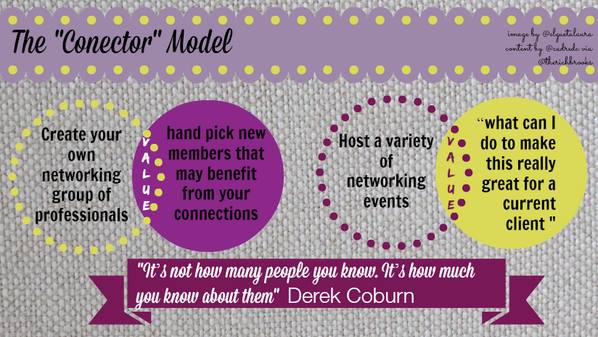
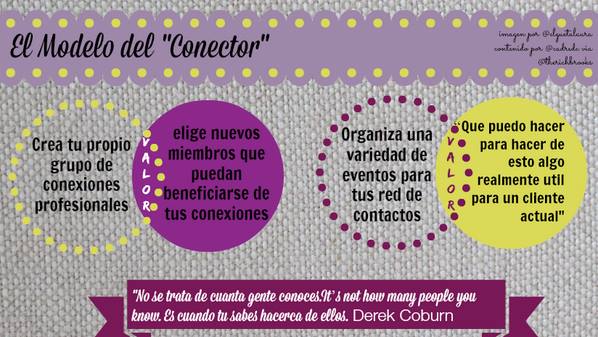
Rich Brooks
Takes the “working” out of “networking.”
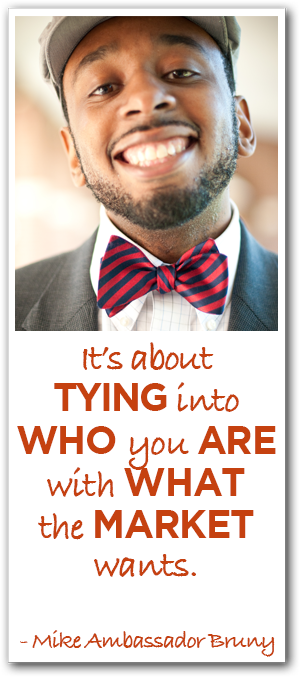 Finding your business’s personal brand doesn’t mean you have to leave your true self at home. You should be proactive when finding your brand, after all, your brand is your business’s reputation. It’s how other people see you, as well as how you want them to see you.
Finding your business’s personal brand doesn’t mean you have to leave your true self at home. You should be proactive when finding your brand, after all, your brand is your business’s reputation. It’s how other people see you, as well as how you want them to see you.